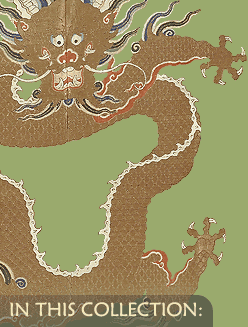 |
When the nomadic Manchu warriors overthrew the Ming dynasty in 1644 and founded Ch'ing, they took over the world's largest population, greatest bureaucracy, and one of the most luxurious courts in existence. They remained, however, a clear minority, ethnically and culturally different than the agrarian-based Chinese they now ruled and whose vast cultural legacy they had inherited.
To ease an orderly political transition while guarding against total cultural assimilation, the Manchus adjusted to a Chinese style bureaucracy and adopted the Buddhist religion while simultaneously enforcing certain ethnic and cultural differences.
One of the clearest distinctions made was that of court attire. Official court robes were changed from the skirted, voluminous, wide-sleeved red gowns of Ming to the yellow, tight-sleeved, side fastening, slit robes, trousers, and riding boots of a nomadic warrior society during Ch'ing. These robes represented one of the most sumptuous, symbolic, and technically accomplished systems of official dress ever developed.
The color, symbolism, and accessories of prescribed garments worn by all men and women associated with the dragon throne delineated distinctions between nobility, official title, and social status.
Official court dress for both men and women was divided into three basic categories: formal (ch'ao-fu), semiformal (ch'i-fu), and informal (ch'ing-fu).
The most common type of court robe is the semiformal variety of ch'i-fu. This was the classic "dragon robe" worn by all who attended court or served in the imperial government.
The color yellow was reserved for robes worn by the emperor, empress, empress dowager, and heir apparent. Most other nobles and officials were required to wear brown or blue semiformal robes. The exact rank of a court official could be ascertained by the color of their robe, type of dragon symbolism, materials used to decorate their accessories, color of the finial stone topping their hat, and the animal represented on their insignia badge.
The standard symbolism of a dragon robe is essentially a schematic diagram of the Chinese universe: a celestial landscape of mountains, oceans, and clouds within which five-clawed imperial dragons coil and twist. The upper part of the robe is a cloud-filled register symbolizing heaven within which nine gold dragons, a long-standing symbol of imperial authority, cavort. The colorful hem register below with its prismatic mountains and wave patterns represented the earth. The emperor's domain of heaven and earth was thus clearly established in visual terms by the ch'i-fu robe. |